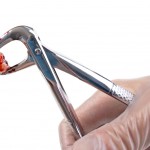
Following tooth extraction the supporting alveolar bone remodels with most of the changes occurring in the first three months. Reductions in the bucco-lingual width of up to 50% have been reported along with reductions in ridge height. Studies reporting approaches of alveolar ridge preservation (ARP) first appeared in the 1980s. The aim of this review was to assess the clinical effects of various materials and techniques for ARP after tooth extraction compared with extraction alone or other methods of ARP, or both, in patients requiring dental implant placement following healing of extraction sockets.
Methods
Searches were conducted in The Cochrane Oral Health Group’s Trials Register, The Cochrane Central Register of Controlled Trials (CENTRAL), Medline, Embase, LILACS, Web of Science Conference Proceedings, Scopus, ProQuest Dissertations and Abstracts service, OpenGrey, Meta Register of current Controlled Trials, ClinicalTrials.gov, and the World Health Organization International Clinical Trials Registry Platform.
Two reviewers independently selected studies, extracted data and assessed the risk of bias in the included studies. Randomised controlled trials (RCTs), including split-mouth trials on the use of ARP techniques, with at least six months of follow-up were considered. Standard Cochrane analysis approaches were followed.
Results
- 8 RCTs involving a total of 233 extraction sites in 184 patients were included.
- 1 study was at unclear risk of bias and 7 at high risk of bias.
- 2 trials (70 patients-moderate quality) compared xenograft with extraction alone with some evidence of reduction in loss of alveolar ridge height (MD -2.60 mm; 95% CI -3.43 to -1.76) and width (MD -1.97 mm; 95% CI -2.48 to -1.46).
- 1 trial (24 patients-low quality) compared allograft with extraction showing reduction ridge height (MD -2.20 mm; 95% CI -0.75 to -3.65) and width (MD – 1.40 mm; 95% CI 0.00 to -2.80) and height.
- There was no evidence of reduction in loss of ridge height in 2 studies comparing alloplast versus xenograft.
- There was insufficient evidence to determine whether there are clinically significant differences between different ARP techniques and extraction based on the need for additional augmentation prior to implant placement, complications, implant failure, or changes in peri-implant marginal bone levels and probing depths of neighbouring teeth.
- No trials which evaluated parameters relating to clinical attachment levels, specific aesthetic or prosthodontic outcomes.
Conclusions
The authors concluded:
There is limited evidence that ARP techniques may minimise the overall changes in residual ridge height and width six months after extraction. There is also lack of evidence of any differences in implant failure, aesthetic outcomes or any other clinical parameters due to the lack of information or long-term data. There is no convincing evidence of any clinically significant difference between different grafting materials and barriers used for ARP. Further long term RCTs that follow CONSORT guidelines (www.consort-statement.org) are necessary.
Comments
Previous reviews have suggested that some ARP techniques are successful (Dental Elf- 4th July 2014) however they may not have included the most reliable studies. Several of these reviews included studies with shorter duration than the 6 months cut-off required for inclusion in this current review. While this review does show some benefit from some techniques, the supporting evidence is only of moderate to low quality. The large number of variable and the lack of long-term data also mean that the impact on treatment outcomes is uncertain as is the question as to which material or approach is best.
Links
Atieh MA, Alsabeeha NHM, Payne AGT, Duncan W, Faggion CM, Esposito M. Interventions for replacing missing teeth: alveolar ridge preservation techniques for dental implant site development. Cochrane Database of Systematic Reviews 2015, Issue 5. Art. No.: CD010176. DOI: 10.1002/14651858.CD010176.pub2.

Alveolar ridge preservation: limited evidence for current techniques http://t.co/DxXDrNozvB
@monalisa1n the latest ‘lack’= limited? Alveolar ridge preservation: limited evidence for current techniques http://t.co/hPDrSosGZs
Limited evidence for alveolar ridge preservation http://t.co/DxXDrNozvB
limited evidence that socket preservation reduces bone loss http://t.co/DxXDrNozvB
no evidence socket preservation improves look or quality of crowns or bridges. http://t.co/DxXDrNGan9
Don’t miss – Limited evidence for alveolar ridge preservation http://t.co/DxXDrNGan9
Cochrane Oral Health Group Blog on this review now online http://bit.ly/1AKuNqn
Limited evidence that socket preservation reduces bone loss http://t.co/moK6vOaowD via @TheDentalElf
[…] Alveolar ridge preservation: limited evidence for current techniques […]
[…] Alveolar ridge preservation: limited evidence for current techniques […]